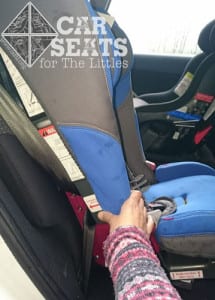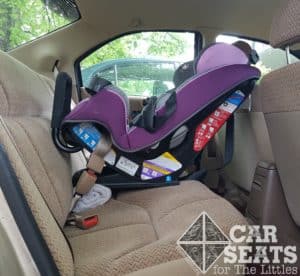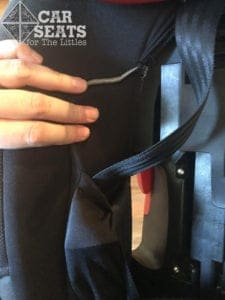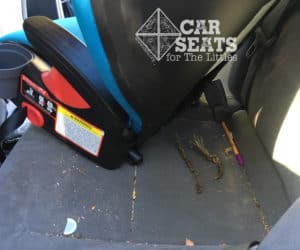If you’re like me, you wonder daily if you spend as much time in your car as you do sleeping. Our cars need service regularly (and, I suppose, so do our beds, if sheet-changing counts). But our cars themselves come with maintenance schedules: what about the safety equipment we put inside them?
Car Seat Maintenance: Regular Installation Checks
As CPSTs, our goal is to empower caregivers to have the confidence to install and use their children’s car seats themselves. But most of us leave car seats in the car for months at a time. Once the car seat is installed, however, we need to make sure it is still properly installed and used correctly on every ride. Here are a few quick tips that can help ensure your child’s car seats are ready to work!
Check for Movement
Every time you use the car seat, make sure that the seat is still correctly installed and properly fits the child who is riding in it. Right before you load your child into the seat, give the car seat a quick handshake at the belt path to confirm that the installation is still secure.
Check for the Correct Rear Facing Recline Angle
For rear facing car seats, take a look at the recline angle: is the seat still installed at the right angle according to the manufacturer’s guidelines and your child’s age? While the angle might be correct when you first install the seat, that could change over time. It’s worth a second look every now and again.
Check the Vehicle Seat Belt
When your car seat is installed with the vehicle seat belt, glance at the seat belt to make sure it’s still buckled.
Tug on the Top Tether
While you’re doing your routine car seat checks, cast an eye at the tether for any forward facing car seat and verify that it still properly attached, tightened, and not interacting with any of the stuff in your trunk.
Don’t Forget the Booster Seat Setup!
For older children who ride in booster seats, make sure their seat belts are still properly routed through their booster seat’s belt guides.
How does the Harness Fit? Things to Check on Every Ride
Harness and Vehicle Seat Belt Fit
Since we need children to have a custom harness fit for every ride, most parents will be tightening and loosening the child’s harness daily. As you buckle your child into their car seat, make sure that your child hasn’t grown overnight: in North America, the straps need to be at or below the child’s shoulders when rear facing, and at or above the child’s shoulders when forward facing.
Harness Straps
Make sure that harnesses and seat belts are not twisted. If, as you tighten, something about the seat feels different, run your hand along the back of the seat (if you can reach it) to make sure that the harness is not caught up or twisted. Most of the time, if tightening a harnessed seat is making you crazy, something is not right with the harness routing. A calm look at the harness from front to back can help in our most frazzled moments.
Check the harness for twists, on the front and the back, and for changes in the webbing: this way you can catch any fuzzing before it becomes fraying. Loosen and tighten the harness to see if you encounter any issues.
Booster Seats
Booster riders grow unexpectedly too: make sure that the shoulder belt is still crossing the child’s shoulder, and the lap belt is sitting low on the hips contacting the thighs. One of the most common mistakes we see is booster riders whose headrests haven’t been raised as the child grows.
Periodic Checks are Important
Car seats are made to be used daily, that’s their job. While doing that very important job, they get a lot of use. Uninstalling and inspecting your child’s car seat when it’s outside of the vehicle from time to time gives you an opportunity to look them over for damage, lost toys, and to extract many, many crumbs from the seat.
Pro Tip: turn the car seat upside down to unleash a small shower of hidden snacks and toys.
Search for Wayward Snacks
Kids can be gross. Wonderful, but: gross. Taking a car seat out periodically gives you the opportunity to shake the seat and see what kind of treasures and bird food fall on the ground. From there you can decide whether to wash the seat cover according to the manufacturer’s directions, and give the car and car seat a quick vacuum.
Check for Hidden Cracks
When the seat is out in the light, check the plastic for stress or cracks. Under regular use, we wouldn’t expect to find these signs, but it’s worth having a look periodically.
Hunt for Missing Train Tracks
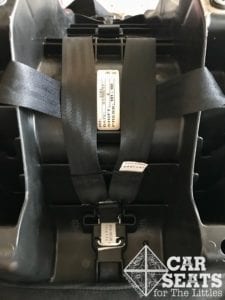
Turn the car seat upside down and check that the harness is properly routed for your child. (Cosco Scenera NEXT Newborn Routing)
If your child’s car seat has a headrest that moves up and down, move it up and down and see if any legos or other treasures fall out. Buckle and unbuckle to make sure there’s no food stuck in the harness release or buckle. Many buckles can be cleaned: check your manual for instructions if you’ve got a sticky crotch buckle.
Check that the seat’s recline mechanism is functional by gently moving it through all its possible angles. As you return it to the correct setting, double check that it is still correct for your child’s weight and age.
Regular Car Seat Check Ups: Keeping Kids Safe
Our cars take us places, but in return, they need regular attention. The safety gear for children that we put in those cars can last for years, but to do so, they also need regular attention. Taking a few minutes to make sure your child’s safety equipment is ready to do its life-saving job can make all the difference in the world when it matters the most.

